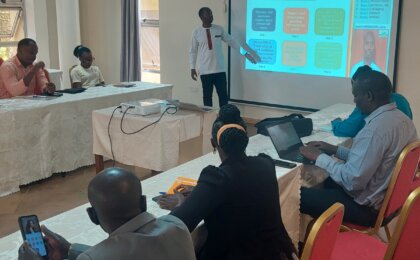Gender-based violence against men in Uganda & the world: The Silent Victims!
Violence against men is one sure trouble you will rarely hear from gender-based violence activists. Sadly, it happens everywhere all the time! It is just that most men are silent. But should they? How deep is it in Uganda and the world? As the world considers #16DaysofActivism, let’s look at gender-based violence against men in Uganda and everywhere else.
During my medical training in first aid and emergency, I was instructed to always pay attention to the ‘silent victims’. ‘In most cases’, the doctor had remarked, ‘silent victims have been hurt so much that they are unable to express their pain or simply their brain power is too overwhelmed to make any words or expressions!’ Could this be happening with boys and men in the global fight against gender-based violence? It resounds the cry of one male refugee:
“You keep on empowering our women – but who comes to talk to us about regaining our dignity and listens to our problems?”

What is violence against men? Understanding the terms!
By definition, gender-based violence is any harm inflicted on an individual or group of individuals by their gender. In other words, for men, it is violence against men because they are men! In 2006, Carpenter defined it as “violence against men or women because of their sex and/or their socially constructed gender roles” (Christian et al., 2011, p. 3). Because we will be referring to sexual and gender-based violence, we should understand these terms: sexual-based violence and gender-based violence. We will borrow these definitions from measure evaluation:
“Sexual violence is any violence, physical or psychological, carried out through sexual means or by targeting sexuality and includes:
- Rape
- Molestation
- Sexual slavery
- Forced marriage
- Being forced to undress or being stripped of clothing
- Insertion of foreign objects in the genital opening or anus
- Forcing two individuals to perform sexual acts on one another or harm one another in a sexual manner (Johnson et al., 2008).
READ THIS TOO: Policy-related factors causing teenage mother deaths
Gender-based violence is a term describing any harm perpetrated against a person that results from unequal power relationships determined by social roles ascribed to males and females (Women’s Wellness Center, 2006). This encompasses a broad range of abuses, from physical and sexual assault to emotional and institutional abuse or the threat of such abuse. For example:
- Slapping, kicking, punching, hitting, beating, choking, burning, shoving
- Threatening with a weapon or had a weapon used against the individual
- Sexual harassment
- Exploitation
- Sex trafficking
- Female genital mutilation
- Forced/early marriage”
Therefore, wherever we say SGBV instead of GBV, we are simply combining all the above troubles (after all, in their happening, they usually happen together!)
Gender-based violence against men in war-zones

Violence against men during war, AI-generated-photo
It is now globally known that, besides girls and women who have over the years suffered violence by reasons of their gender, men and boys also experience gender-based violence during war and, sometimes, in severe forms compared to their female counterparts! For example, a 2009 study by the Peace Research Institute of Oslo (PRIO) indicated that more men die in war than women even though women may die of indirect causes, especially after the war (Ormhaug, 2009).
This contradicts hundreds of reports and UN resolutions that concentrate on women and girls as the major victims of war!
According to Veronique Barbelet, a senior researcher and expert on humanitarian policy and domestic violence especially in East Africa and other African nations, men and boys are targeted in wars because they are thought to be a threat or direct combatants or participants. These killings are gender-oriented and deserve justice as well (Veronique, 2014).
In 1995, during the Srebrenica genocide, about 8,000 children were massacred on the grounds they were male and thus possible warfighters (Mikaberidze, 2013). Historically, including the Biblical historical wars or conflicts, men and boys were always the target of war based on their gender, for example, the massacre of innocent male children in Jesus’ times (Matthew 2).
A 2016 study in Darfur (Sudan) by Ferrales and friends identified gender-based violence against men during war in four categories; homosexualization, feminization, genital harm, and sex-selective killings (Ferrales et al., 2016). While it is clear that men and boys suffer SGBV in war times just as women and girls do (or even more), few reports cover this (Ferrales et al., 2016). According to Christian et al. (2011), in a 2011 study in DRC, male survivors of SGBV don’t report it for these reasons: survivor’s shame, fear of retaliation by perpetrators, and stigma from community members.
On a good note, the researchers recognize that media coverage of violence against men and boys during the war has increased, though, on a sad note, there is limited response as most programs are directed toward helping women and girls as the only victims of war (Christian et al., 2011).
Gender-based violence against men in intimate relationships and at work

Wait! If you thought that reports regarding violence against men and boys during the war were scarce, think again; they (reports) are actually nowhere when it comes to violence that men suffer at the hands of their wives or families at home! (Watson et al., 2005). Violence against men in relationships is the same as that against women, inflicting physical, emotional, verbal, sexual, financial, and psychological pain on victims.
Women may control their partners through physical violence (with a knife, gun, kicks and punch, or threatening to poison or kill the man while asleep), threatening children (killing them or taking them away), threatening to file for divorce, telling lies of unfaithfulness or money spending to the husband’s family or friends, belittling him in public or any form of disrespect, taking partner’s medications or anything basic to him, for example, car keys, controlling where he goes and what he says and much more.
Sadly, few men report violence (Watson et al., 2005) for fear of shame, stigmatization, and retaliation from their offenders or fear of divorce or loss of children or the feeling that ‘they won’t be believed by authorities’ (Lupri and Grandin, 2004).
Studies in western countries, for example, Norway, USA, Canada and many others clearly show that violence against men is on increase and, in some cases, much higher than the one against women (Gelles and Straus, 1992; Watson et al., 2005). Apparently, while the general response has been globally low, western countries are taking lead in recognizing violence against men and offering solutions. For example, in Norway, men are legally accepted at crisis centers just as women are! Additionally, though few, some organizations in USA are providing care to men victims of violence.
In relation to work, men have suffered gender-based harassment at work just as women have. In these days of homosexuality and right to sexual orientation, many men have been harassed by their fellow men for sex as well. However, as we earlier said, few men report work related violence based on sex or gender. In United States, 1 out 5 people who complain about workplace sexual harassment is a male. With programs like MeToo at work, many men are coming forward and numbers of male victims are increasing!
It isn’t uncommon for an employee to suffer some injustices simply because he is a male. Practically, most officers (especially women) might deny a man’s formal requests on basis of him being a man, maybe because of insecurity reasons within the officer herself or simply because she has bad feelings about a man taking up such requests or simply because he denied her sex.
Other times, men are segregated from some tasks based on social constraints around work, for example, in nursing. In nursing, it is rare to find a male nurse holding a high office, even when he bears the right qualifications! After all, Nightingale had said, men aren’t fit for nursing! In nursing, men are reserved for hard duties, including night shifts, lifting patients and heavy equipment, and working in work-intensive wards like the ICU, accident and emergency, and cancer units.
Causes of gender-based violence against men
In Africa and Uganda, the closest study I have come across is Janet Mundando and friends’ study in Zambia. Apparently, the study was about domestic violence and not gender or sexual-based violence. There is a difference. However, in practice, it is hard to tell the difference.
Domestic violence simply means within the confines of domestic or relationships or family. It’s any form of violence within that context. As one can see, it encompasses almost everything and anyone is liable to it irrespective of their gender or sexuality!
Back to the study above, the researchers explored the causes of violence against men in intimate relationships. According to the study report, the causes of violence against men are: poor financials, infidelity, beer drinking, non-involvement in household chores, suspicions and jealousy, husband’s late coming, and dependence of husbands on their wives (lacking source of income) (Mundando et al., 2016).
Wait! Looking at these reasons, can we blame women for the ‘violence’? Whatever the cause, it’s still violence! Again, these are causes of domestic violence and not SGBV. Olivia Giovetti explores the 3 major causes of gender-based violence in all settings: harmful gender norms (societal cultures and beliefs regarding gender and gender roles), hunger (I would call this, poverty), and war or conflicts.
Of course, the reasons why women abuse men are a little different from the ones why men abuse women. However, considering gender, they share one ingredient: exploiting the sex or power relations between sexes as described by society regarding gender roles. For example, men are expected to be strong, independent, and breadwinners of their families (Migliaccio, 2002). Attacks from women usually exploit these areas.
A detailed article on BBC explores the relationship between the community’s expectations of ‘man up’ among men and suicide rise and concludes: “The really courageous thing to do is to face your problems, face the pain that you’re suffering. Trying to fix it, that’s what’s really courageous”. In other words, true ‘manning up’ among men should be about reporting all forms of violence they face and seek help in time. On the other hand, men exploit women’s general physical and emotional weakness and societal cultures and norms regarding women.
Sexually & gender-based violence against men in Uganda
A detailed report regarding sexual and gender-based violence in times of Kony (LRA) in Northern Uganda indicate that, just like women and girls, men suffered injustices of forced sex, molestation, forced labor, and forced fighting in combat. According to the report and different witnesses, men were sodomized and cruelly raped by both Kony soldiers and Uganda’s NRA soldiers.
A 2011 UDHS report by UBOS said that nearly 60% of all men between 15-49 years have ever experienced a form of domestic violence. In 2012, Akumu Patience cited that 40% of domestic violence in Uganda was against men. In her write-up, Where Do Battered Men Go, she unearths how men, just like women, are forced to do rituals and cultural practices they don’t want. In her words:
‘In Mbale district today, men are forcefully checked to ascertain if they have undergone the circumcision ritual, in conformity with the Gishu culture. Tales of the brutal arrests and forceful circumcision the men go through are rife, but somehow they never receive that much attention. In fact, any form of sexual and gender-based violence against men is always scoffed at or laughed off’.
In 2013, gender activist, Twinomugisha Ben, wrote in Daily monitor about abuses of women against men in which case they (women) deny them (men) sex, food or close them outside house. ‘In some homes’, adds Twinomugisha, ‘women lead constant criticism, belittling husband’s abilities and competency, initiating name-calling insults, silent treatment to their husbands and have also mastered the art of manipulation of feelings and emotions to induce guilt, subvert husband’s relationship with the children and repeatedly make and break promises’.
And, as Peace Akumu had earlier noted, Twinomugisha recognizes the fact that none (the society or the law) recognizes this torture:
‘Uganda that has largely remained a patriarchal society, for a man to admit being harassed by a woman is desperately humiliating and, in a way seen as shameful. Even worse is the fear of humiliation by a husband who wants to go public and declare being abused by his wife. Domestic violence against men in Uganda is not well recognized by the law enforcers with the generalized perception that men cannot be victims of violence’ (Twinomugisha, 2013).
Sadly, the current 16 Days of Activism against GBV in Uganda and the whole world are still about women more than they are about men. To the world, men aren’t victims but perpetrators. Those who are victims suffer less or are simply lying! And the story goes on, when no one is hearing to no one; men not listening to women and women not listening to men.
We can’t overcome GBV before we address these differences! The only time men and boys are talked of is when they are being called upon to ‘protect women or girls’ but not to be protected themselves.
SGBV against men: Consequences and the way forward
Just as it is for women and girls, the consequences of SGBV among men are detrimental and, sometimes, worse since men don’t discuss these issues or seek help. In most cases, men become insecure, suffer psycho-social traumas, and end up ‘losing it’ or hurting their friends or wives, for example, wife murder.
These consequences can be deeper, affecting future relationships, societal performance, and poor economics, leading to poverty. Men who have been belittled suffer serious depression, anxiety, and episodes of aggression. For details, read this article.
The way forward: Men, man up by reporting any violence and seeking help as you may feel. It doesn’t matter what everyone else thinks or says. Men need care too.
Formal solutions include incorporation of men into all national efforts to fight against SGBV, both in government and among NGOs. Men, just like women, are victims of SGBV and, if we are interested in finding a solution, we cannot leave them behind.
Again, it is important to note that as many men report these cases, more data is accumulated, which is helpful in advocacy and calls for policy changes. Therefore, report, report, and report any SGBV against men. For personal solutions, see this article. At Miklah and all our other initiatives, men and women, girls and boys are humans who deserve humanity!
SOME REFERENCES
Migliaccio, T. A. (2002). Abused husbands: A narrative analysis. Journal of Family issues, 23(1), 26-52.
Mundando, J., Gadsen, F., & Kusanthan, T. (2016). Domestic Violence against Men in Intimate Relationship: An Experience Learned from Men in Zambia. Journal of Education and Literature, 4(2), 50-60.
Gelles, R. J., & Straus, M. A. (1992). Physical violence in American families: risk factors and adaptations to violence in 8145 families.
Lupri, E., & Grandin, E. E. (2004). Intimate partner abuse against men. National Clearinghouse on Family Violence.
Mikaberidze, A. (Ed.). (2013). Atrocities, Massacres, and War Crimes: An Encyclopedia [2 Volumes]: An Encyclopedia. ABC-CLIO.
Watson, D., & Parsons, S. (2005). Domestic abuse of women and men in Ireland: Report on the national study of domestic abuse. Government Publications Office.



